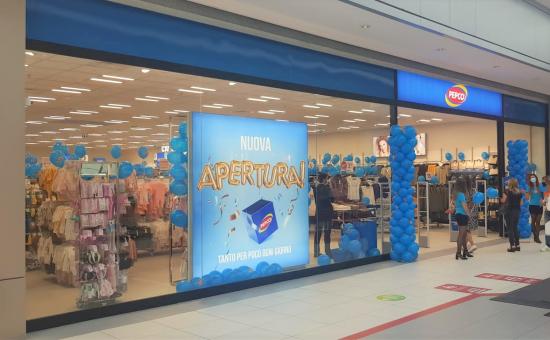The mood is positive once again. Encouraging signals provided by the retailers’ sales which, in the four month period June – September 2021, returned to levels seen in the same period 2019

IGD is seeing clear signs of recovery in the sales of the mall retailers. In the meantime, the digital marketing project is taking on an increasingly more precise form, as is the Next Steps project which focuses on new ways to understand shoppers changing preferences.
Let’s learn more about these topics from Daniele Cabuli, Chief Operating Officer, who will provide us with an updated picture as to what his team is doing and the phenomenon that are emerging.
What trends have you seen in your shopping centers over the last few months?
Considering the restrictions we have had to deal with in order to manage our retail businesses in the last two years, I would say that we are currently going through a good period, with performances showing decided improvement with respect to 2020 even if it has only been since May that we haven’t been subject to mandatory closures. Overall, even though the footfalls ae still lower than before the pandemic, the retailers’ sales are recovering, thanks also to an increase in the average ticket. In August 2021, for example, there was a decided acceleration in retailers’ sales with an increase of 3.7% against August 2019. In the period June – September 2021, our tenants reported sales in line with the same period of 2019, confirming the trend already seen in the past few months, namely less frequent, but more targeted shopping: the average ticket in September was, in fact. 8.5% higher compared to September 2020 and 21.7% higher than in September 2019.
Is the positive mood affecting all product categories or are there differences based on the type of activity?
If we succeeded in recovering a couple of percentage points in the vacancy rate post-lockdown, bringing the financial occupancy in Italy to 95.4% at the end of September 2021, it’s because the underlying sentiment is positive for all, even though, naturally, the dynamics for revenues differed. Even the restaurant sector, which was hit extremely hard by the restrictions, expressed a great desire for a fresh start, proposing new formulas. We also accelerated the reletting of the spaces that remained vacant as a result of the pandemic with the introduction of new brands like Ilovepokè, Ristofficine and Pepco, along with well-established ones like Toysuper, Undercolors of Benetton and Stroili…
Which retailers saw the biggest increase in their revenues?
The big apparel names like Zara and Oviesse performed really well and home care continues to report good results as a result of the focus on maximizing domestic comfort given the greater amount of time spent at home in this last period of time. In spite of those who feared eCommerce would be a source of overwhelming competition, consumer electronics continue to post large increases in sales thanks to the purchases of devices needed for remote working and promotional offers for televisions and decoders needed to receive programs using the new digital terrestrial standards. As special events and ceremonies resumed, the jewelry sector also received a big boost.
Which sectors are still experiencing difficulties?
Footwear, clearly, did not show the positive dynamics that the big clothing brands did, in part attributable to the financial difficulties of a few major brands. ervices, like hairdressers and dry cleaners, also continue to report lackluster performances which we think could be explained, in part, by the high percentage of people who are still working from home who used to use these shopping center services during their lunchbreaks. In addition to restaurants, up until now, movie theaters were among the retailers most affected by the restrictions and, more recently, by the lack of new movies. We expect to see a change of pace after the debut of films that were released recently like the new James Bond movie or the ones that are slotted to be released in theaters over the Christmas holidays.
Why haven’t footfalls returned to the 2019 levels?
We believe that there are some economic, as well as more structural, reasons. In the first instance, all we can do is wait until the operating conditions are fully recovered; while, with respect to the changes in shoppers’ behavior that we think could last, we have to be proactive.
Let’s begin with the reasons that are more connected to the current environment …
Firstly, many companies have maintained remote working: this still has a noticeable impact on restaurants’ lunch and afterwork business. Secondly, up until now, the organization of large events, which in the past attracted thousands of people, was prohibited. Things are about to change, however: in just a few weeks we are about to start again with a new calendar of events during which compliance with all health precautions will be strictly enforced.
There are, however, also factors viewed as more structural shifts in behavior …
As we have seen in the different studies and surveys we conducted, including the last survey completed in September, leisure time habits are changing. Clearly over the last few months, as the anti-Covid restrictions were lifted, open air events were preferred, also because of the good weather. This penalized footfalls in our centers, particularly over the weekends. As the long period of mild weather comes to an end and winter approaches, we expect to see a recovery of at least part of the footfalls. We can’t, however, limit ourselves to counting on this dynamic alone. A few new behavior models are emerging: while young people want to return to the previous way of living, we have found that the over 55 tend to avoid going to the shopping center unless they really need to purchase something.
What tools are you using to stimulate an increase in shopping center traffic?
We recently began using a new CRM system which allows us to implement digital market campaigns, much are more effective than generalized ones as they are based on targeted user profiles. We are, therefore, creating a reserved area on the website of each shopping center where the users will be rewarded based on the type of interactions. We were pleasantly surprised by the first results, as we saw that a significant number of over-55 also used our platform. If, in terms of marketing, we have completely changed the playing field, inside the shopping center we continue to introduce new brands and formats. In addition to the rapid changes made to meet new needs, like the creation of outdoor restaurant spaces, we are preparing a series of other initiatives driven by the Next Steps project.
Have there been any new developments in the Next Steps projects since the last edition of News&Views?
The Next Steps initiatives were presented to and examined by the Board of Directors during a specific seminar. The directors expressed their appreciation for the new ideas in terms of both layouts and the proposed mix. At this point, we will test the new formulas in a few shopping centers, assess the results and make any changes needed before proceeding with a large-scale launch. The investments for these initiatives are not excessive, but we want to target them effectively.
How do the footfalls at IGD’s centers compare with those of the sector in Italy?
Our footfalls are in line with the sector average provided by CNCC, the Consiglio Nazionale dei Centri Commerciali. To be precise, they are slightly higher, thanks to the fact that we do not have any jumbo centers, the type that is still suffering the most, in our portfolio.
What do you expect to see between now and the end of the year?
If we look back at 2020, it was in these exact weeks that new restrictions were implemented due to an increase in infection rates. Today, with more than 80% of the population over 12 years old vaccinated, the situation is entirely different. For many types of merchandise, the holidays bring sales equal to three months on average: with the shopping centers finally open always and our plan to start again with a program of organized events, the prospects are encouraging.
Thanks and buon lavoro.
Share




